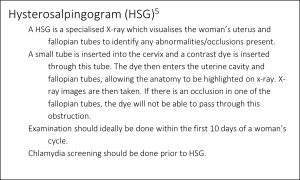The British Fertility Society defines infertility as ‘a disease of the reproductive system defined by the failure to achieve a pregnancy after 12 months or more of regular unprotected sex (without contraception) between a man and a woman”.
In this article, we will review female factor infertility.
Causes of Female Factor Infertility
The causes broadly can be split into the following categories:
- Disorders of ovulation – most common cause of infertility in women
- Tubal causes
- Uterine/peritoneal causes
- Other causes
Disorders of Ovulation
WHO has classified ovulation disorders into 3 categories:
- Group I: hypothalamic pituitary failure (10%)
- Hypothalamic amenorrhoea – can be due to low body weight/excessive exercise
- Hypogonadotrophic hypogonadism e.g. due to Kallmann syndrome
- Group II: hypothalamic-pituitary-ovarian (85%)
- Predominately PCOS
- Group III: ovarian failure (4-5%)
- Hypergonadotropic hypogonadism
Tubal Causes
- Pelvic inflammatory disease (PID) – see our article on PID for more information
- Endometriosis
- Previous sterilisation
Uterine + Peritoneal Causes
- Endometriosis
- Previous pelvic surgery (formation of adhesions, including intrauterine)
- Uterine fibroids
- Uterine anomalies
- Cervical factors
Other
- Unexplained
- Genetic factors
- Immune factors and systemic illnesses
- Medications: chemotherapy and cytotoxic agents
- Lifestyle factors: smoking, excessive alcohol, obesity
Primary Care Investigations
Investigations should be commenced after 1 year in couples who have not conceived, despite regular unprotected sexual intercourse (every 2-3 days).
- Mid-luteal phase progesterone – to assess ovulation
- Measured 7 days before expected period (i.e. day 21 of a 28-day cycle)
- Chlamydia screening
- Testing for susceptibility to rubella
- The following investigations may be considered:
- Serum progesterone in women with prolonged irregular menstrual cycles
- Gonadotrophins in women with irregular menstrual cycles – FSH and LH – may help identify ovulation disorders
- Thyroid function tests if the symptoms are suggestive
- Prolactin if the symptoms are suggestive of an ovulatory disorder, pituitary tumour or there is evidence of galactorrhoea
Referral to secondary care
Refer to local guidelines for specific referral criteria.
For women less than 36 years of age:
NICE states that a referral to secondary care should be considered if “the history, examination and investigations are normal in both partners and the couple have not conceived after 1 year”
NICE recommendations for when to consider an earlier referral
- Age 36 and older – refer after 6 months
- Amenorrhoea or oligomenorrhoea
- Previous surgery (abdominal or pelvic)
- Previous pelvic inflammatory disease (PID)
- Previous STI
- Abnormal pelvic examination
- Known reason for infertility e.g. previous cancer treatment
Secondary care investigations
Tubal patency tests
- If no comorbid conditions:
- Hysterosalpingography – screens for tubal occlusion
- Hysterosalpingo-contrast ultrasonography – an alternative to look for tubal occlusion
- If comorbid conditions (including pelvic inflammatory disease and endometriosis):
- Diagnostic laparoscopy and dye – tubal and other pelvic abnormalities can be assessed simultaneously

Management of Infertility in Women
Lifestyle management
- Weight management (aim for BMI of 19-25 kg/m2)
- Psychological stress management
Medical treatment
- Clomifene (anti-oestrogen drug) for induction of ovulation (e.g. anovulation in PCOS)
- Gonadotrophins may be considered in women who do not respond to clomifene
- Pulsatile gonadotrophin-releasing hormone can induce ovulation
- Dopamine agonists may be used for ovulatory disorders that are secondary to raised prolactin
Surgical treatment
- Tubal microsurgery (tubal catheterisation or cannulation) in women with mild tubal disease
- Laparoscopy for excision or ablation of endometriosis
- Laparoscopic ovarian drilling may be considered in women who do not respond to clomifene
- Laparoscopic ovarian cystectomy in presence of endometriomas
- Laparoscopic salpingectomy in presence of hydrosalpinx
References
- nice.org.uk. 2018.Scenario: Initial assessment | Management | Infertility | CKS | NICE. [online] Available at: <https://cks.nice.org.uk/topics/infertility/management/initial-assessment/> [Accessed 9 June 2022].
- Hornstein, M., Kuohong, W. Up-To-Date: Evaluation of female infertility (Initial Approach). [online] Available at: https://www.uptodate.com/contents/evaluation-of-female-infertility. [Accessed July 1, 2022].
- nice.org.uk. 2018.Causes of infertility | Background information | Infertility | CKS | NICE. [online] Available at: <https://cks.nice.org.uk/topics/infertility/background-information/causes-of-infertility/> [Accessed 9 June 2022].
- nice.org.uk. 2018.Scenario: Management | Management | Infertility | CKS | NICE. [online] Available at: <https://cks.nice.org.uk/topics/infertility/management/management/> [Accessed 9 June 2022].
- Leaflet titled: “Having an X-ray of your uterus and fallopian tubes”, University Hospitals of Leicester, 2019. Accessed through: Leicesterfertilitycentre.org.uk. n.d.Gynaecological Investigations. [online] Available at: <https://www.leicesterfertilitycentre.org.uk/patients/private-treatment/gynaecological-investigations/> [Accessed 9 June 2022].
- NICE Guideline CG156, 2013. Fertility problems: assessment and treatment. [online] Available at: <https://www.nice.org.uk/guidance/cg156/resources/fertility-problems-assessment-and-treatment-pdf-35109634660549> [Accessed 9 June 2022]
- NICE Guideline NG73. Endometriosis: Diagnosis and Management. [online] Available at: https://www.nice.org.uk/guidance/ng73/chapter/Recommendations#surgical-management-if-fertility-is-a-priority [Accessed July 1, 2022)
